#Agricultural systems
Text
Strengthening the resilience of agricultural systems and food security in the Sahel.
The Sahel region, while holding significant potential, grapples with formidable challenges hindering its journey to food and nutrition security, sustainable employment, income opportunities, and environmental preservation. Escalating violence, conflict, and the presence of extremist groups, compounded by instability, poverty, and political crises, have exacerbated the region's difficulties.
The event aims to:
Reflect on the need for longer-term programmes, embedded in national policies, to complement and over time reduce the need for humanitarian assistance, in a context of multidimensional crisis and unprecedented needs.
Deepen the understanding of WFP's resilience-building approach and initiatives by showcasing one of the organization's flagship programmes, supported.
Take stock of the challenges, achievements and lessons learned since the scale-up of resilience programming in the Sahel.
Present the next phase of the Integrated Resilience Programme (2024-28)
Call for other partners to join this effort in the Sahel.
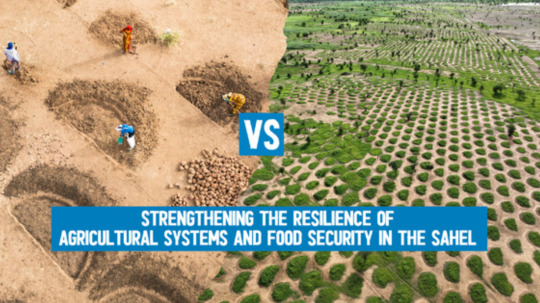
#resilience-building approach#resilience-building initiative#food security#sahel#agricultural systems#agriculture and desertification
0 notes
Text
Here’s how bioscience is revolutionizing food systems without synthetic chemicals
0 notes
Text
Reallocation through land use change.

The donor region becomes urbanized, leading to a change from agricultural to urban water use as land use changes.
#Donor region#recipient region#rural areas#urban areas#water reallocation#Agricultural systems#urban water systems#water flow#municipal water#agricultural water#water reservoir
0 notes
Text
"In response to last year’s record-breaking heat due to El Niño and impacts from climate change, Indigenous Zenù farmers in Colombia are trying to revive the cultivation of traditional climate-resilient seeds and agroecology systems.
One traditional farming system combines farming with fishing: locals fish during the rainy season when water levels are high, and farm during the dry season on the fertile soils left by the receding water.
Locals and ecologists say conflicts over land with surrounding plantation owners, cattle ranchers and mines are also worsening the impacts of the climate crisis.
To protect their land, the Zenù reserve, which is today surrounded by monoculture plantations, was in 2005 declared the first Colombian territory free from GMOs.
...
In the Zenù reserve, issues with the weather, climate or soil are spread by word of mouth between farmers, or on La Positiva 103.0, a community agroecology radio station. And what’s been on every farmer’s mind is last year’s record-breaking heat and droughts. Both of these were charged by the twin impacts of climate change and a newly developing El Niño, a naturally occurring warmer period that last occurred here in 2016, say climate scientists.
Experts from Colombia’s Institute of Hydrology, Meteorology and Environmental Studies say the impacts of El Niño will be felt in Colombia until April 2024, adding to farmers’ concerns. Other scientists forecast June to August may be even hotter than 2023, and the next five years could be the hottest on record. On Jan. 24, President Gustavo Petro said he will declare wildfires a natural disaster, following an increase in forest fires that scientists attribute to the effects of El Niño.
In the face of these changes, Zenù farmers are trying to revive traditional agricultural practices like ancestral seed conservation and a unique agroecology system.
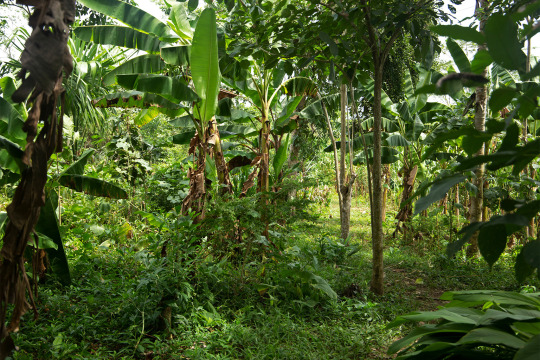
Pictured: Remberto Gil’s house is surrounded by an agroforestry system where turkeys and other animals graze under fruit trees such as maracuyá (Passiflora edulis), papaya (Carica papaya) and banana (Musa acuminata colla). Medicinal herbs like toronjil (Melissa officinalis) and tres bolas (Leonotis nepetifolia), and bushes like ají (Capsicum baccatum), yam and frijol diablito (beans) are part of the undergrowth. Image by Monica Pelliccia for Mongabay.
“Climate change is scary due to the possibility of food scarcity,” says Rodrigo Hernandez, a local authority with the Santa Isabel community. “Our ancestral seeds offer a solution as more resistant to climate change.”
Based on their experience, farmers say their ancestral seed varieties are more resistant to high temperatures compared to the imported varieties and cultivars they currently use. These ancestral varieties have adapted to the region’s ecosystem and require less water, they tell Mongabay. According to a report by local organization Grupo Semillas and development foundation SWISSAID, indigenous corn varieties like blaquito are more resistant to the heat, cariaco tolerates drought easily, and negrito is very resistant to high temperatures.
The Zenù diet still incorporates the traditional diversity of seeds, plant varieties and animals they consume, though they too are threatened by climate change: from fish recipes made from bocachico (Prochilodus magdalenae), and reptiles like the babilla or spectacled caiman (Caiman crocodilus), to different corn varieties to prepare arepas (cornmeal cakes), liquor, cheeses and soups.
“The most important challenge we have now is to save ancient species and involve new generations in ancestral practice,” says Sonia Rocha Marquez, a professor of social sciences at Sinù University in the city of Montería.
...[Despite] land scarcity, Negrete says communities are developing important projects to protect their traditional food systems. Farmers and seed custodians, like Gil, are working with the Association of Organic Agriculture and Livestock Producers (ASPROAL) and their Communitarian Seed House (Casa Comunitaria de Semillas Criollas y Nativas)...
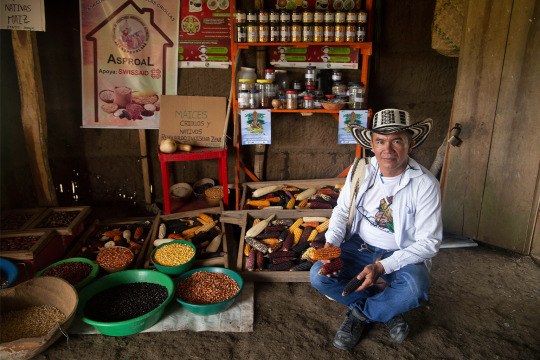
Pictured: Remberto Gil is a seed guardian and farmer who works at the Communitarian Seed House, where the ASPROL association stores 32 seeds of rare or almost extinct species. Image by Monica Pelliccia for Mongabay.
Located near Gil’s house, the seed bank hosts a rainbow of 12 corn varieties, from glistening black to blue to light pink to purple and even white. There are also jars of seeds for local varieties of beans, eggplants, pumpkins and aromatic herbs, some stored in refrigerators. All are ancient varieties shared between local families.
Outside the seed bank is a terrace where chickens and turkeys graze under an agroforestry system for farmers to emulate: local varieties of passion fruit, papaya and banana trees grow above bushes of ají peppers and beans. Traditional medicinal herbs like toronjil or lemon balm (Melissa officinalis) form part of the undergrowth.
Today, 25 families are involved in sharing, storing and commercializing the seeds of 32 rare or almost-extinct varieties.
“When I was a kid, my father brought me to the farm to participate in recovering the land,” says Nilvadys Arrieta, 56, a farmer member of ASPROAL. “Now, I still act with the same collective thinking that moves what we are doing.”
“Working together helps us to save, share more seeds, and sell at fair price [while] avoiding intermediaries and increasing families’ incomes,” Gil says. “Last year, we sold 8 million seeds to organic restaurants in Bogotà and Medellín.”
So far, the 80% of the farmers families living in the Zenù reserve participate in both the agroecology and seed revival projects, he adds."
-via Mongabay, February 6, 2024
#indigenous#ecology#agroforestry#agriculture#traditional food systems#traditional medicine#sustainable agriculture#zenu#indigenous peoples#farming#colombia#indigenous land#traditional knowledge#seeds#corn#sustainability#botany#plant biology#good news#hope#climate action#climate change#climate resilience#agroecology#food sovereignty
1K notes
·
View notes
Note
Idea: orchard harvester saddle. More of a standing platform with a scooter handlebar for the rider where the centaur can hand things up and down. (playing Farming Simulator is making me crave more peaceful/agricultural world building; there's already so much Warlike WB around, it needs some balance)
(also, eat like a horse vs eat like a bird, horse metab is high efficiency but a lot of it just due to net size, imagine that efficiency applied to refined grains and breads. Centaur diets would be less-per-weight than humans, although not necessarily by much due to the metabolic needs of sapient brain and foretorso)
Ohhhh I absolutely love this and absolutely think it should be a thing. I've been thinking more about the inherent benefits of centaurs in an agrarian society and more and more the borders of the Merchant city has been expanding outward towards the edge of Rider territory with enormous matriarchal farm towns that feed most of the surrounding societies so this would fit right in to that kind of lifestyle! And sounds so useful! One doing the moving and loadbearing, one doing the climbing and picking.
And I agree, war shapes societies undeniably but so many worldbuilders forget that trade, craft and industry shape cultures and societies just as much! It's definitely a topic i could GO OFF about haha, I have major exports and interrelated trade agreements drawn up between ALL my current societies 😁
(also absolutely, the use of refined grains and bread was a huge part of my initial thoughts about how centaurs could survive feeding that big horse body with comparatively small/limited human teeth. The efficiency of processed grain and grass fibers would be SO necessary to their digestion and overall survival!)
#asked and answered#centaurs#agricultural pursuits#i have DESIGNS#for the rural merchant centaurs#it started with designing their homes#and then turned into a whole matriarchal time share family system#completely unique from the city centaurs#of the merchant culture#also good food thoughts#feeding that high energy brain#AND#that big horse body#would still require a lot of food#but the magic of human intervention#is the power of processed foods#and the beautiful glut of calories they provide
50 notes
·
View notes
Text
youtube
Our soil is degrading, droughts increasing and once fertile land turning into desert (www.decadeonrestoration.org ). But there are glimmers of hope:
Sometimes the biggest global changes are driven by local communities and their leaders, Africa’s smallholder farmers, for example. Hundreds of thousands of people are now coming together to revive their lands – by turning dried up monoculture plots into forest gardens. Learn how it works!
African Farmers Restoring Food Systems, led by Trees for the Future, has been recognized as a World Restoration Flagship under the UN Decade on Ecosystem Restoration.
#good news#africa#food forests#food systems#farmers#agriculture#farming#sustainable farming#environmentalism#science#environment#nature#conservation#climate change#Youtube
21 notes
·
View notes
Note
hello! I've just found your blog and that's AMAZING, but I have a question: what do you think about industrial food? it's super low quality, and furthermore, they produce a lot of trash as plastic (unnecessary) packaging! It would be easier just to say "starting eating organic food", but for poor people, buying grapes or apples, even not organic, costs more than buying cookies full of fat, sodium and carbohydrates (not talking about all the chemicals). I personally, think about non conventional food plants as an alternative since most of them are super resistant to weather changes and easy to rise. I wanna know what you think about
Hi! Thanks for getting in touch. The long and short of it is, I hate industrialised farming. It pollutes the air, soil and water, poisons and impoverishes farmers, increases the likelihood of zoonotic pandemics, reduces the genetic diversity of plants and encroaches upon wildlife territories. We need a massive return to local, small-scale regenerative agriculture if we are to feed everyone and equitably share the earth with other species. But you’re right, it has to be done in a way that’s just and fair for people who can currently only afford plasticked, pesticided and processed food, as well as making a living for farmers. We’re all on the same side here, but people often don’t realise that. I also think we need to massively diversify our food plant range - a system that relies on just a few staple crops is insanely vulnerable, especially with more and more extreme weather coming our way. So many plants I was raised to think of as ‘weeds’ are not only edible but highly nutritious and often medicinal. Where are the dandelion farmers? The mycologists selling turkey tails? And foraging should be taught in all schools so kids can feed themselves in the wild and pass these skills on to future generations. As with most climate solutions, I don’t think it’s an either/or - I’d welcome pretty much any solution as part of a wider melting pot of alternatives. The only thing I won’t budge on is that we have to change, because the way we in the North and West farm right now just isn’t sustainable.
#solarpunk#hopepunk#cottagepunk#environmentalism#social justice#community#farming#food systems#organic#agriculture#agroecology#regenerative farming#plants#foraging#diet#ask#fuck industrial farming
23 notes
·
View notes
Text
I have too many interests and it stresses me out quite often
#oh what to do#languages biology ecology agriculture plants food systems history painting drawing#endless endless
7 notes
·
View notes
Text
i have once more Read a Book !
the book was jim morris' cancer factory: industrial chemicals, corporate deception, & the hidden deaths of american workers. this book! is very good! it is primarily about the bladder cancer outbreak associated with the goodyear plant in niagara falls, new york, & which was caused by a chemical called orthotoluedine. goodyear itself is shielded by new york's workers' comp law from any real liability for these exposures & occupational illnesses; instead, a lot of the information that morris relies on comes from suits against dupont, which manufactured the orthotoluedine that goodyear used, & despite clear internal awareness of its carcinogenicity, did not inform its clients, who then failed to protect their workers. fuck dupont! morris also points out that goodyear manufactured polyvinyl chloride (PVC) at that plant, and, along with other PVC manufacturers, colluded to hide the cancer-causing effects of vinyl chloride, a primary ingredient in PVC & the chemical spilled in east palestine, ohio in 2023. the book also discusses other chemical threats to american workers, including, and this was exciting for me personally, silica; it mentions the hawks nest tunnel disaster (widely forgotten now despite being influential in the 30s, and, by some measures, the deadliest industrial disaster in US history) & spends some time on the outbreak of severe silicosis among southern california countertop fabricators, associated with high-silica 'engineered stone' or 'quartz' countertops. i shrieked about that, the coverage is really good although the treatment of hawks nest was very brief & neglected the racial dynamic at play (the workers exposed to silica at hawks nest were primarily migrant black workers from the deep south).
cancer factory spends a lot of time on the regulatory apparatus in place to respond to chemical threats in the workplace, & thoroughly lays out how inadequate they are. OSHA is responsible for setting exposure standards for workplace chemicals, but they have standards for only a tiny fraction—less than one percent!—of chemicals used in american industry, and issue standards extremely slowly. the two major issues it faces, outside of its pathetically tiny budget, are 1) the standard for demonstrating harm for workers is higher than it is for the general public, a problem substantially worsened during the reagan administration but not created by it, and 2) OSHA is obliged to regulate each individual chemical separately, rather than by functional groups, which, if you know anything at all about organic chemistry, is nonsensical on its face. morris spends a good amount of time on the tenure of eula bingham as the head of OSHA during the carter administration; she was the first woman to head the organization & made a lot of reasonable reforms (a cotton dust standard for textile workers!), but could not get a general chemical standard, allowing OSHA to regulate chemicals in blocks instead of individually, through, & then of course much of her good work was undone by reagan appointees.
the part of the book that made me most uncomfortable was morris' attempt to include birth defects in his analysis. i don't especially love the term 'birth defect'—it feels cruel & seems to me to openly devalue disabled people's lives, no?—but i did appreciate attention to women's experiences in the workplace, and i think workplace chemical exposure is an underdiscussed part of reproductive justice. cancer factory mentions women lead workers who were forced to undergo tubal ligations to retain their employment, supposedly because lead is a teratogen. morris points at workers in silicon valley's electronics industry; workers, most of them women, who made those early transistors were exposed to horrifying amounts of lead, benzene, and dangerous solvents, often with disabling effects for their children.
morris points out again & again that we only know that there was an outbreak of bladder cancer & that it should be associated with o-toluedine because the goodyear plant workers were organized with the oil, chemical, & atomic workers (OCAW; now part of united steelworkers), and the union pursued NIOSH investigation and advocated for improved safety and monitoring for employees, present & former. even so, 78 workers got bladder cancer, 3 died of angiosarcoma, and goodyear workers' families experienced bladder cancer and miscarriage as a result of secondary exposure. i kept thinking about unorganized workers in the deep south, cancer alley in louisiana, miners & refinery workers; we don't have meaningful safety enforcement or monitoring for many of these workers. we simply do not know how many of them have been sickened & killed by their employers. there is no political will among people with power to count & prevent these deaths. labor protections for workers are better under the biden administration than the trump administration, but biden's last proposed budget leaves OSHA with a functional budget cut after inflation, and there is no federal heat safety standard for indoor workers. the best we get is marginal improvement, & workers die. i know you know! but it's too big to hold all the same.
anyway it's a good book, it's wide-ranging & interested in a lot of experiences of work in america, & morris presents an intimate (sometimes painfully so!) portrait of workers who were harmed by goodyear & dupont. would recommend
#if anyone knows about scholarship that addresses workplace chemical exposure#& children born with disabilities through a disability justice lens please recommend it to me!#booksbooksbooks#have reached the point in my Being Weird About Occupational Safety era where i cheered when familiar names came up#yay irving j. selikoff champion of workers exposed to asbestos! yay labor historians alan derickson & gerald markowitz!#morris points out the tension between workers - who want engineering controls of hazards (eg enclosed reactors)#& employers who want workers to wear cumbersome PPE#the PPE approach is cheaper & makes it even easier to lean on the old 'the worker was careless' canard when occupational disease occurs#i just cannot stop thinking about it in relation to covid. my florida library system declined to enforce masks for political reasons#& reassured us that PPE is much less important than safety improvements at the operational & engineering level#but they didn't do those things either! we opened no windows; upgraded no HVACs; we put plexi on the service desks & stickers on the floors#& just as we have seen covid dangers downplayed or misrepresented workers still do not receive useful information about chemical hazard#a bunch of those MSDS handouts leave out carcinogen status & workers had to fight like hell to even be told what they're handling#a bunch of them still do not know—consider agricultural workers & pesticide exposures. to choose an obvious & egregious example.
8 notes
·
View notes
Text

I love science. But also, I can clearly see how it is the western man’s explanation of explicit indigenous knowledge. ESPECIALLY in agriculture and food systems. Isn’t it quite interesting to think about how regenerative agriculture was THE way of living. We’ve strewn so far from this form of food production that now rich white women with masters degrees and inherited land get to teach others “regenerative agriculture” for profit. It irritates me that our culture (mostly white culture) needs the chemical, biological, physical, scientific proof that something works when oral traditions have been tried and true on this continent for 10,000 years. Is the scientific method a means of distraction so big ag, big pharma, big oil, and big chem can make a profit?
#the circle of capitalism#western science#indigenous knowledge#same language#agriculture#regenerative agriculture#indigenous voices#food systems#native rights#sustainability#fuck capitalism#life#wicked witch#green anarchy#the wicked witch of the east#why does tumblr hate me#big ag#small ag#circular#solarpunk#profit#profit to the people#united we stand
44 notes
·
View notes
Text
Inter-basin reallocation.

Long distances across hydrological basin boundaries.
#Donor region#recipient region#rural areas#urban areas#water reallocation#Agricultural systems#urban water systems#water flow#municipal water#agricultural water#water reservoir#hydrological basin#river basin
0 notes
Text
"A global shift to a mostly plant-based “flexitarian” diet could reduce greenhouse gas emissions and help restrict global heating to 1.5C, a new study shows.
Previous research has warned how emissions from food alone at current rates will propel the world past this key international target.
But the new research, published in the Science Advances journal, shows how that could be prevented by widespread adoption of a flexitarian diet based around reducing meat consumption and adding more plant-based food.
“A shift toward healthy diets would not only benefit the people, the land and food systems,” said Florian Humpenöder, a study author and senior scientist at the Potsdam Institute for Climate Impact Research, “but also would have an impact on the total economy in terms of how fast emissions need to be reduced.” ...
The researchers found that adopting a flexitarian diet could lower methane and nitrous oxide emissions from agriculture and lower the impacts of food production on water, nitrogen and biodiversity. This in turn could reduce the economic costs related to human health and ecosystem degradation and cut GHG emissions pricing, or what it costs to mitigate carbon, by 43% in 2050.
The dietary shift models also show limiting peak warming to about 1.5C can be achieved by 2045 with less carbon dioxide removal, compared with if we maintain our current diets.
“It’s important to stress that flexitarian is not vegetarian and not vegan,” Humpenöder says. “It’s less livestock products, especially in high-income regions, and the diet is based on what would be the best diet for human health.”
In the US, agriculture accounts for more than 10% of total GHG emissions. Most of it comes from livestock. Reducing meat consumption can free up agricultural land used for livestock production, which in turn can lower methane emissions. A potent greenhouse gas, methane is mainly expelled from cows and other animals raised for livestock. Animal production is the primary contributor to air quality-related health impacts from US food systems.
“This paper further confirms what other studies have shown, which is that if we change our diets to a more flexitarian type, we can greatly reduce greenhouse gas emissions,” said Jason Hill, a professor in the University of Minnesota’s department of bioproducts and biosystems engineering.
According to the study authors, one way to achieve a shift toward healthier diets is through price-based incentives, such as putting taxes on the highest-emitting animal products, including beef and lamb. Another option is informing consumers about environmental consequences of high meat consumption."
-via The Guardian, March 27, 2024
#flexitarian#vegetarian#vegan#environment#environmental news#agriculture#big agriculture#beef#methane#air pollution#greenhouse gasses#carbon emissions#1.5 degrees#climate action#climate hope#good news#hope#food#food systems
149 notes
·
View notes
Note
🐾 - How do they get their food?
For humans inside the heavens especially, do they get rations or do they just go to a store? or do the stores get rations like when a place is in conflict/crisis and things are limited or do they try to act as if it's normal? ...or do they have everything very controlled and strict but they act as if it's normal... I got myself ranting in circles but anyways. Possibilities ✨
There’s actually an entire safe haven solely dedicated to agriculture, growing crops and tending to livestock. The goods are regularly transported to the other safe havens, where they are stored in special storage facilities and placed in stores for civilians to shop in.
They also have farming operations outside of the walls (that are protected) of other safe havens that give them an added surplus.
They also have a few special “aviaries” where they harvest tropical fruits and other resources, among other things. Though, the food from these places is more limited in supply and not as available to the public (they are working to try and fix that). It’s like premium goods that you have to know when they’ll be available so you can get them and if not, you have to wait for the next time (if that makes sense).
Those who run the safe haven society are very conscious of food supply because starving people are unhappy people. So, they make sure that no one is without food and that they have stored food in case of an unexpected famine or shortage.
#woodnote ask#worldbuilding#about humans#about the safe havens#about the green havens#< agriculture safe havens#about the aviaries#a little bit#I’d say that they have the whole food industry under a very controlled and steady system
4 notes
·
View notes
Text
The Inca Empire was an ancient civilization known for its remarkable engineering achievements, with many remnants found today in Peru. Here we take a look at 10 of the most famous engineering marvels of the Inca Empire.
38 notes
·
View notes
Text
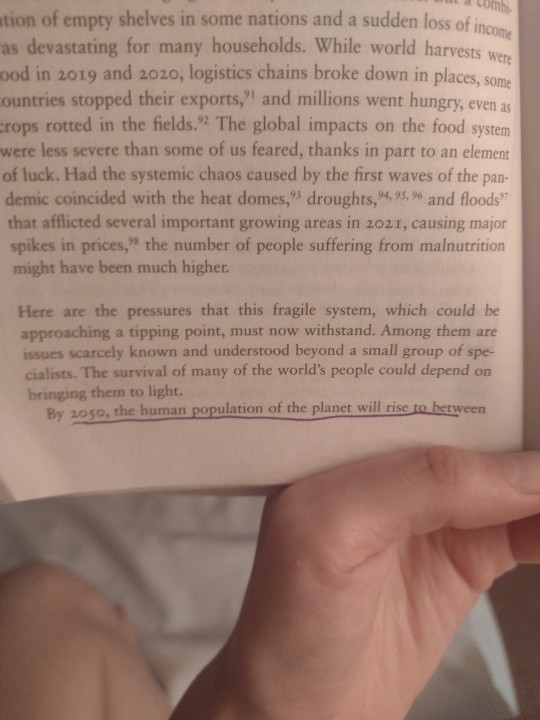

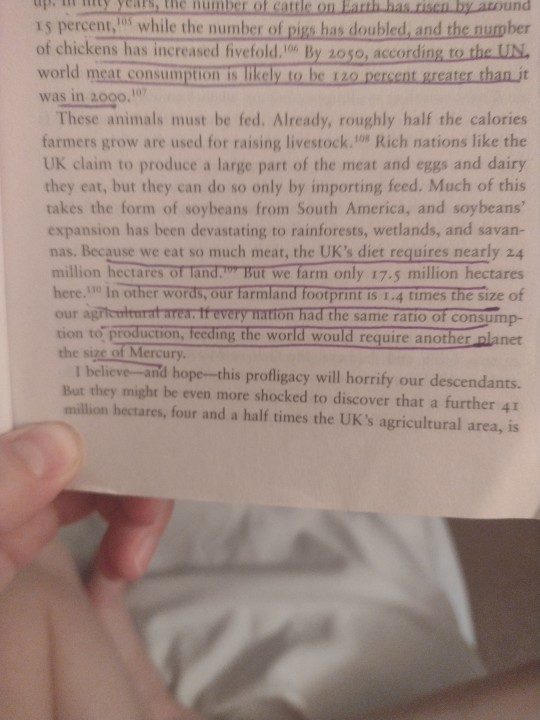
From Regenesis: Feeding the World Without Devouring the Planet by George Monbiot
24 notes
·
View notes
